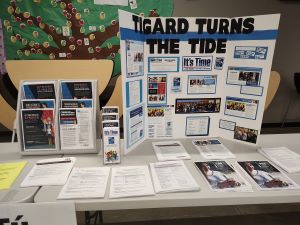|
Back to Prevention Stories
Raising Voices Saving Lives
Hosted by:
Tigard Turns the Tide Parent and Youth Group and Stop Tigard Underage Drinking and Drugs

Please briefly describe your Communities Talk activity.
A community event was held in person at Tigard High School to raise awareness of the risks associated with substance misuse. We had several other organizations join us with tables. We distributed “Talk. They Hear You.” materials. Here is the link to the livestream: https://www.youtube.com/watch?v=OoRpwfCLhF8

How does alcohol and other drug misuse affect your community?

Our Tigard Turns the Tide Coalition is a work in progress and is currently in phase one of adopting the Communities That Care (CTC) process. We are working together with local leaders, schools, law enforcement, city government, parents, youth, faith community, businesses, and others to address the rising concerns with substance misuse. Our benchmark is to identify health and behavior issues to be addressed to confirm that CTC is appropriate for our efforts. The CTC prevention-planning system focuses on building positive youth development by addressing risk and protective factors that are predictive of six adolescent health and behavior problems: substance abuse, juvenile delinquency, teen pregnancy, school dropout, youth violence, and depression and anxiety.

Which prevention strategy(ies), as defined by SAMHSA’s Center for Substance Abuse Prevention, best fit your Communities Talk activity?
- Environmental Strategy - focuses on establishing or changing community standards, codes, and attitudes thereby influencing incidence and prevalence of alcohol and other drug use within the community. The strategy depends on engaging a broad base of community partners, focuses on places and specific problems, and emphasizes public policy.
- Community-Based Process Strategy - focuses on enhancing the capacity of the community to address AOD issues through organizing, planning, collaboration, coalition building, and networking.
- Information Dissemination Strategy - focuses on improving awareness and knowledge of the effects of AOD issues on communities and families through “one-way” communication with the audience such as speaking engagements, health fairs, and distribution of print materials.
- Education Strategy - focuses on “two-way” communication between the facilitator and participants and aims to improve life/social skills such as decision making, refusal skills, and critical analysis.

What goal(s) did you hope to accomplish with your Communities Talk activity?
- Hold meetings or discussion groups on alcohol and/or other drug misuse prevention.
- Create alcohol and/or other drug misuse prevention action groups (e.g., committees, task forces, and advisory boards).
- Start a youth-led coalition on alcohol and/or other drug misuse prevention.
- Develop strategic plans to reduce and prevent alcohol and/or other drug misuse.
- Build coalitions with other agencies or programs to reduce and prevent alcohol and/or other drug misuse.
- Work with my local legislators or policymakers to educate about the importance of changes to, or recommend enforcement of, existing laws and policies.

Did you accomplish your goal(s)?
Yes

What challenge(s) did you face in planning your activity this year?

How did you overcome these challenges?
We were pleased with our event. We had a few scheduling conflicts but had a good turnout.

What are your next steps?

- Host follow-up meetings or activities
- Expand our coalition with new partnerships in the community
- Support new prevention policies, legislation, or social ordinances
- Conduct research efforts to learn more about issues in our community
- Create a public education campaign to raise awareness and/or change behaviors around underage drinking (i.e., create PSAs and other promotional materials)

If you’ve conducted Communities Talk activities in prior years, how has your repeated participation contributed to progress in achieving your prevention goals?
We continue to partner and collaborate with other organizations to achieve our goal and to include the community.

Organizations that conduct Communities Talk activities often involve other organizations in the planning and execution of events. Please indicate which type(s) of organizations you involved in your activity planning.
- Law enforcement
- Youth-led organizations
- Secondary schools
- Local chapters of national organizations
- Charitable organizations
- Local businesses
- State and local government agencies (e.g., public health departments)

Which of the following best describes the primary audience(s) for your Communities Talk activity?
- Youth
- Parents
- Teachers or other education staff
- Prevention specialists and volunteers
- Law enforcement officials
- Legislators or policymakers
- The media
- Asian community members
- Black or African American community members
- Hispanic community members
- Native Hawaiian or Other Pacific Islander community members
- Lesbian, gay, bisexual, or transgender (LGBTQ) community members

How did you reach and engage your primary audience(s) to encourage them to participate in your activity?
Through social media and middle and high school parents.

Which Communities Talk resources (or other SAMHSA resources) were most helpful for your activity?

- SAMHSA’s Event Planner
- Tips & Tools for Hosting a Virtual Event
- Customizable Resources for Communities Talk Promotion and Implementation
- Communities Talk website
- Communities Talk planning guides
- Communities Talk toolkits
- Communities Talk social media content (e.g., Facebook, Twitter)
- Communities Talk support staff
The Tigard Turns the Tide Parent and Youth Group and Stop Tigard Underage Drinking and Drugs hosted a community event at Tigard High School to raise awareness about alcohol and drug misuse. The event featured resource tables, roundtable discussions, and a town hall meeting.
|
|